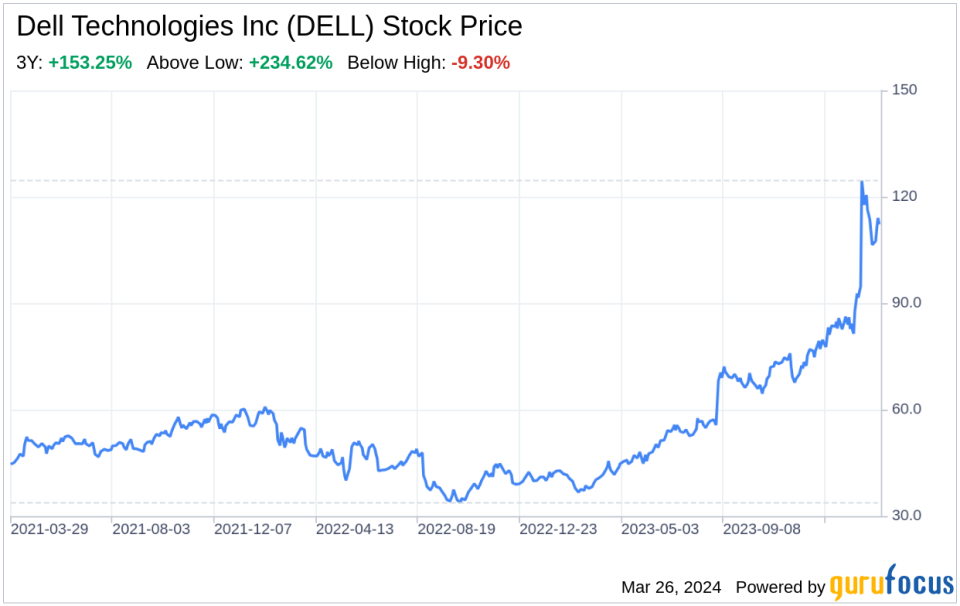Decoding Dell Technologies Inc (DELL): A Strategic SWOT Insight
Robust portfolio and innovation in AI and cloud-based solutions position Dell as a leader in IT infrastructure.
Flexible consumption models and Dell Financial Services drive recurring revenue and customer loyalty.
Global supply chain and manufacturing prowess provide Dell with a competitive edge.
Market competition and rapid technological changes present ongoing challenges for Dell.
On March 25, 2024, Dell Technologies Inc (NYSE:DELL) filed its 10-K report, revealing a comprehensive view of its financial health and strategic positioning. Despite a decrease in total net revenue from $102,301 million in Fiscal 2023 to $88,425 million in Fiscal 2024, Dell managed to increase its net income from $2,422 million to $3,195 million in the same period. This financial resilience is a testament to Dell's robust operational strategies and its ability to navigate the dynamic tech landscape. With a focus on innovation and customer-centric solutions, Dell continues to be a formidable player in the IT industry.

Strengths
Market Leadership and Innovation: Dell Technologies Inc (NYSE:DELL) stands out with its comprehensive portfolio, especially in AI and cloud-based solutions. With a total R&D expenditure of $2.8 billion in both Fiscal 2024 and Fiscal 2023, Dell demonstrates a strong commitment to innovation. This investment fuels the development of cutting-edge technologies, ensuring Dell's products remain competitive and relevant. The company's ability to capture growth as customer spending priorities evolve is a clear strength, as seen in its leading positions in personal computers, servers, and storage solutions.
Financial Services and Consumption Models: Dell's flexible consumption models, including as-a-Service and subscription-based offerings, contribute to a growing stream of recurring revenue. Dell Financial Services (DFS) funded $8.4 billion of originations in Fiscal 2024, maintaining a $10.5 billion portfolio of high-quality financing receivables. This financial arm not only supports product sales but also strengthens customer relationships by providing operational and financial flexibility, which is crucial in retaining and expanding Dell's customer base.
Global Supply Chain and Manufacturing: Dell's global supply chain and manufacturing capabilities are a significant strength. With facilities across the United States, Malaysia, China, Brazil, India, Poland, and Ireland, and a strategy that includes both in-house manufacturing and contract manufacturers, Dell can optimize production, maintain quality, and ensure timely delivery. This flexibility and efficiency in operations give Dell a competitive advantage in meeting customer demands and managing costs.
Weaknesses
Revenue Decline: The 10-K filing reveals a notable decline in Dell's total net revenue, dropping from $102,301 million in Fiscal 2023 to $88,425 million in Fiscal 2024. This reduction could signal underlying weaknesses in certain product lines or market segments. It's imperative for Dell to analyze the causes of this decline and address potential issues in its offerings or marketing strategies to prevent further erosion of its market share.
Dependence on Component Suppliers: Dell's reliance on a network of suppliers, including single-source or limited-source vendors, presents a vulnerability. Any disruption in the supply chain, whether due to geopolitical tensions, trade disputes, or other factors, could adversely affect product availability, delivery, and costs. This dependence on external parties for critical components requires diligent risk management to mitigate potential negative impacts on Dell's operations.
Competitive Market Pressures: The tech industry is characterized by rapid innovation and intense competition. Dell faces challenges from both established players and emerging disruptors. As competitors continue to innovate and potentially enter into strategic partnerships, Dell must continuously evolve its offerings and maintain its competitive edge to avoid losing market share.
Opportunities
Expansion in Emerging Markets: Dell's global presence in over 170 countries provides ample opportunities for growth, especially in emerging markets. These regions represent a significant portion of the world's population and are experiencing rapid technological adoption. By tailoring solutions to meet the unique needs of these markets, Dell can capitalize on this potential for expansion and diversify its revenue streams.
Advancements in AI and Cloud Computing: The ongoing digital transformation across industries presents opportunities for Dell to leverage its strengths in AI and cloud computing. As businesses seek to modernize their IT infrastructure, Dell's integrated solutions are well-positioned to meet these demands. The company's focus on AI, software-defined, and cloud-native infrastructure solutions aligns with current and future market needs, offering a pathway for growth.
Strategic Investments and Acquisitions: Dell's venture capital arm, Dell Technologies Capital, targets investments in emerging technology areas relevant to its business. These strategic investments and potential acquisitions can accelerate Dell's innovation agenda, enhance its product portfolio, and drive long-term growth.
Threats
Rapid Technological Changes: The pace of technological advancement in the IT industry is relentless. Dell must continuously innovate to keep up with these changes and meet evolving customer expectations. Failure to do so could result in obsolescence and a loss of competitiveness. Dell's ability to anticipate and respond to technological shifts is critical to its long-term success.
Macroeconomic Fluctuations: Global economic conditions, including interest rate changes, inflation, and currency fluctuations, can impact Dell's operations and financial performance. These macroeconomic factors can affect customer spending, supply chain costs, and overall market stability. Dell must navigate these uncertainties and adapt its strategies accordingly to maintain financial stability.
Regulatory and Compliance Risks: Dell operates in a highly regulated environment, with laws and regulations affecting various aspects of its business. Compliance with these regulations, including
This article, generated by GuruFocus, is designed to provide general insights and is not tailored financial advice. Our commentary is rooted in historical data and analyst projections, utilizing an impartial methodology, and is not intended to serve as specific investment guidance. It does not formulate a recommendation to purchase or divest any stock and does not consider individual investment objectives or financial circumstances. Our objective is to deliver long-term, fundamental data-driven analysis. Be aware that our analysis might not incorporate the most recent, price-sensitive company announcements or qualitative information. GuruFocus holds no position in the stocks mentioned herein.
This article first appeared on GuruFocus.
